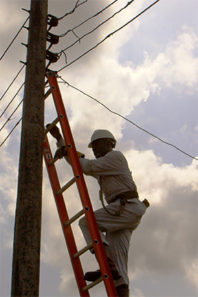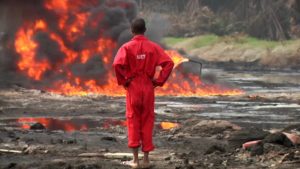
Filipino-Canadian director Shasha Nakhai’s Take Light has the illusion of having a large scope. However, it mostly focuses on those working to provide or to take away electricity from Nigerians. This is mostly a good thing. She shows them occasionally singing as they get ready for a full day of work. Her main subject is Martins, an electrician who is candid about things like his childhood.
Martins has to work hard to pay all of his bills, including electricity, which Nigerian businesses treat as a luxury. The other subjects also treat energy as a finite resource. This goes against common knowledge that the country is the richest in Africa because of their gas and diesel reserves. There should be enough of those natural resources and riches to go around for everybody but that’s not true, apparently.
And that’s because their developing infrastructure isn’t developing fast enough to serve their 200 million customers. Nakhai makes us pay attention to the machines converting gas to electricity. These look something like audiences would see in 1970s disaster dramas. “The machines are like human beings too,” Martins says, commenting on the fragility of the system creating his livelihood. But in doing so he implies that these machines take precedence. Precedence over the people who should be benefiting from them.
Take Light then shows off some visual dynamics. It eventually branches out to portraying not just those serving Nigeria but also portraying Nigerian laymen. There are social media posts. One is a video of Martins becoming unconscious after a section of the power grid electrocutes him. There are also the Youtubers complaining about said electricians.
These Youtubers are James and Harry and call themselves the Two Angry Men. As the camera zooms out, it shows us that they live in a nice house. As someone who grew up in a country poorer than Nigeria, most of the houses we see are equally habitable. They’re unlike the shacks and houses that most people assume when they hear “living in Africa”. They have enough power and time to post their videos.
But the lights can go out any minute, even if they’re paying full price for half the service. At the same time, these angry men aren’t totally angry. They point out how oil workers have dangerous jobs because of customer ire. This is one of Take Light‘s assets. It provides levity before it returns to depicting those who have to return to their daily grind.
Another of those assets is that it’s a documentary about people. There could have been a mix of both laymen and expert think tanks but the former outweighs the latter, thankfully. And who else to explain the complexities of the country’s energy situation? The movie depicts those whose boots are on the ground and listens to them. It does hate same to those with voices angry enough to be viral.
One of the movie’s few setbacks though is how news-y it is. Even the Two Angry Men contribute to this. There are also the radio and TV new anchors with their posh voices calmly explaining this alarming crisis. Although it explains most of the crisis’ factors, thankfully.
There’s another thing that the film does repeatedly that also veers into highlighting conflict but only slightly. We see a lot of Martins and his co-worker, Deborah. She confronts customers who they allege are using more energy than they’re paying. These scenes take up a chunk of the doc’s relatively short running time. Nakhai could have padded it out by balancing these confrontations with other angles showing the crisis’ effects on Nigerians.
Nonetheless, this doc exposes truths about the crisis. Eventually, we get to hear from some of the think tanks. People pointing out how much power companies waste energy that could be going to customers. It connects Nigeria’s methods of wasting energy to climate change and to the terrorist groups that have gained worldwide notoriety. There are some missteps here but it gives light to something serious.
- Release Date: 10/29/2018


